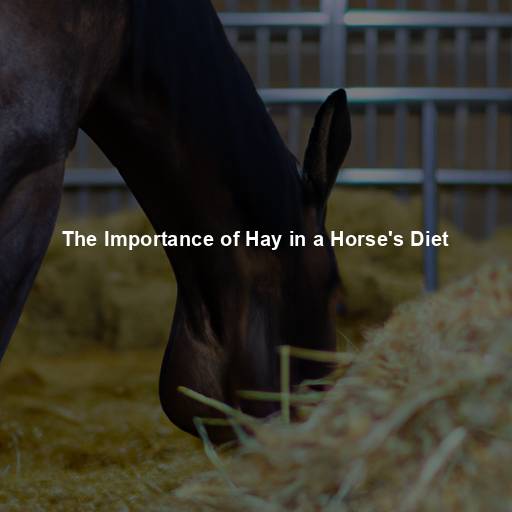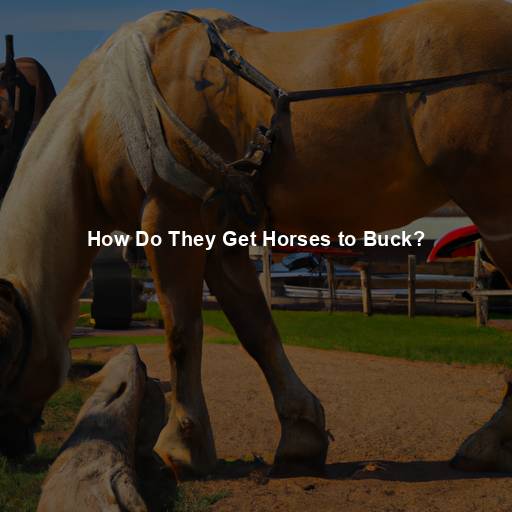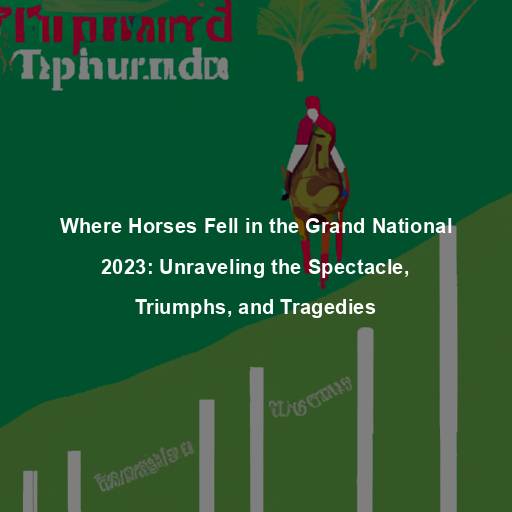The Importance of Hay in a Horse’s Diet
Last Updated on November 1, 2023 by Evan
Contents [hide]
- 1 Understanding the Role of Hay in a Horse’s Nutrition
- 1.1 Hay: A Staple in a Horse’s Diet
- 1.2 Nutritional Composition of Hay
- 1.3 Hay as a Source of Fiber
- 1.4 Maintaining a Healthy Weight with Hay
- 1.5 Hay for Dental Health
- 1.6 Types of Hay for Horses
- 1.7 Feeding Hay: Best Practices
- 1.8 Hay Alternatives
- 1.9 Factors Affecting Hay Quality
- 1.10 Selecting the Right Hay for Your Horse
- 1.11 Supplementing Hay with Grains and Concentrates
- 1.12 Preventing Hay-Related Issues
- 1.13 Proper Hay Storage
- 1.14 Feeding Hay to Horses
- 2 FAQs – Why do horses eat hay?
Understanding the Role of Hay in a Horse’s Nutrition
Equines, those awe-inspiring creatures that captivate our hearts, seem to possess a mesmerizing blend of elegance, power, and allure that beckon admiration from the corners of the globe. Naturally, as conscientious guardians of these charismatic beings, it becomes our inescapable obligation to provide them with unparalleled care, orchestrating a symphony of wellness in their lives. One might ponder, “What key element grants horses the vitality they so effortlessly radiate”? The answer resounds unexpectedly in the humble embrace of hay.
Hay: A Staple in a Horse’s Diet
Grass, legumes, and a little bit of magic – that’s the secret recipe for hay, the nutritional superhero in a horse’s diet. This quirky concoction not only nourishes our equine companions with all the essential nutrients they need, but also gives their digestive systems a proper workout. Picture this: horses, the ultimate grazers, munching on small portions of hay throughout the day, keeping their weight in check and their tummies satisfied. So, when fresh pasture is scarce, hay rides in like a trusty sidekick, ready to fuel their grazing adventures.
Nutritional Composition of Hay
When it comes to the well-being of horses, hay takes the reins. Packed with fiber, it gallops straight towards a healthy digestive system, ensuring smooth and efficient digestion. With its diverse range of vitamins and minerals, hay is the nutritional knight in shining armor, safeguarding their overall health. While the composition may be as unpredictable as a wild horse, influenced by factors such as grass type, harvest maturity, and storage conditions, hay never disappoints in delivering the essential energy, protein, vitamins, and minerals that horses crave.
Hay as a Source of Fiber
Fiber, the unsung hero of a horse’s meal plan, plays a vital role in maintaining their digestive well-being. This dietary champion skillfully navigates through the equine digestive tract, warding off the phantom of colic and other troublesome tummy tormentors. The humble hay, with its fiber-rich goodness, becomes a formidable ally in the delicate dance of equine oral health, as its chomping prowess produces saliva, acting as a dental defender. As if these benefits weren’t enough, fiber’s fermenting finale in the horse’s hindgut unleashes a powerful ensemble of volatile fatty acids, serving as a source of energizing magic.
Maintaining a Healthy Weight with Hay
Hay plays a crucial role in maintaining a horse’s weight. For horses that require weight gain, high-quality hay can provide the necessary calories to help them reach a healthy body condition. Conversely, for horses that need to lose weight, feeding lower-calorie hay or restricting hay intake can help achieve the desired weight loss. The ability to control a horse’s calorie intake through hay makes it an invaluable tool in managing their weight.
Hay for Dental Health
Did you know that a horse’s pearly whites are in a constant state of growth? It may seem perplexing, but their teeth keep on sprouting throughout their lives. Now, maintaining their dental well-being is no small task, but it’s crucial for their overall health. Here’s where hay comes into the picture – munching on this fibrous delight helps horses naturally grind down their teeth, keeping those pesky sharp points and dental irregularities at bay.
Types of Hay for Horses
When it comes to hay for horses, the options can leave you feeling both intrigued and perplexed. With a captivating array of choices, each boasting its own unique blend of nutrients, the quest to find the perfect match for your equine companion can be quite the adventure. Amongst the hay varieties that reign supreme are timothy, orchard grass, alfalfa, and clover, each shrouded in a captivating allure. The esteemed timothy hay, renowned for its harmonious nutritional composition, finds favor amongst a diverse range of horses.
Feeding Hay: Best Practices
When feeding hay to horses, it is essential to follow some best practices to ensure their health and well-being. Here are a few guidelines to consider:
- Quality: Choose hay that is free from mold, dust, and weeds. High-quality hay should have a fresh smell, a green color, and be free from foreign objects.
When it comes to providing nourishment for our equine companions, it’s important to consider a myriad of factors. Each horse possesses its own unique set of requirements, encompassing age, weight, and activity level. As a general rule of thumb, offering an adequate quantity of hay equating to roughly 1.5% to 2% of a horse’s body weight per day is recommended. Careful attention to these variables ensures a well-rounded approach to equine nutrition.
- Access: Horses should have access to hay throughout the day, mimicking their natural grazing behavior. This can be achieved by using hay nets, slow feeders, or providing multiple hay feedings throughout the day.
When it comes to preserving the nutritional goodness of hay and warding off the pesky mold, a foolproof storage plan is key. Make sure to secure your stash in a spotless, dry nook, far from the clutches of sunlight and dampness. This will keep those nutrients intact and keep moldy surprises at bay!
Hay Alternatives
While hay has long been a go-to for horses when it comes to their diet, there are intriguing alternatives that can be considered for those with special needs or limited access to hay. These captivating alternatives encompass haylage, hay cubes, and complete feeds, offering a sense of wonder and perplexity. Haylage, a remarkable fermented forage, boasts a higher moisture content and can be the perfect choice for horses grappling with respiratory difficulties or chewing difficulties. Hay cubes present a burst of novelty as they are compacted blocks of hay that can be soaked in water, creating a softer and more easily digestible option for horses with dental issues.
When it comes to a horse’s diet, hay is more than just a filler. It plays a crucial role in providing essential nutrients, aiding digestion, and keeping their weight in check. But not all hay is created equal, and the quality matters significantly. From the type of grasses and legumes used to the way it is grown, harvested, and stored, there are several factors that contribute to the nutritional value of hay.
Factors Affecting Hay Quality
The nutritional value and overall effect hay has on a horse’s health and well-being cannot be overstated. The intricacies behind the quality of hay are multifaceted and can perplex even the most seasoned horse owners. From the type of grasses used, to the harvesting and storage methods employed, every step in the hay-making process adds an element of uncertainty. The burstiness of factors such as moisture content, protein levels, and the presence of weeds in hay keeps horse owners constantly on their toes as they strive to provide the best for their equine companions.
Harvesting Time
The stage at which the hay is harvested can affect its nutritional value. Early-cut hay tends to be more nutrient-rich and higher in protein, while late-cut hay may have lower nutritional content but can still be suitable for some horses, such as those with restricted diets or certain health conditions.
Storage Conditions
Ensuring that hay remains in top-notch condition demands our utmost attention. The formidable trio of moisture, sunlight, and unwanted critters has the ability to thwart our efforts and compromise the hay’s quality. It is imperative to safeguard this invaluable resource by securing it in a sheltered, well-ventilated space, whether that be a barn or utilizing a trusty tarp to shield it from the elements. This relentless effort is driven by one ultimate goal: to preserve the nutrient-rich essence that lies within the fibers of hay.
Weeds and Foreign Matter
Hay should be free from weeds, dirt, dust, and foreign objects. Weeds not only reduce nutritional value but can also pose health risks to horses. Regular inspection and removal of any contaminants from the hay are crucial to ensure the horse’s safety.
Selecting the Right Hay for Your Horse
Selecting the perfect hay for your equine companion requires careful deliberation, taking into account their unique needs and nutritional prerequisites. A myriad of factors come into play when making this decision, aiding you in deciphering the ideal choice.
Age and Activity Level
When it comes to horses at different stages of life, their nutritional needs can fluctuate like a wild rollercoaster ride. Take those sprightly foals and growing youngsters, for example. They demand a hay type that’s packed with protein and vital nutrients like alfalfa, giving them the fuel they need to thrive. On the flip side, older horses or those dealing with specific health issues may need a hay that’s lower in sugar and protein, a bit like a gentle breeze to soothe their weary bodies.
Weight and Body Condition
When it comes to our equine companions, their weight management is of utmost importance. Just like us, horses may have their own unique dietary needs. It has been observed that horses struggling with weight issues can greatly benefit from tailored hay options. In cases where the majestic creatures are on the heavier side, opting for hay varieties that are lower in calories or regulating their hay intake can bring about a positive change.
Dental Health
Dental issues can affect a horse’s ability to chew and digest hay properly. Horses with dental problems may benefit from softer forms of hay, such as hay cubes or chopped hay, which are easier to chew and digest. Soaking hay in water before feeding can also make it more manageable for horses with dental issues.
Supplementing Hay with Grains and Concentrates
When it comes to a horse’s diet, hay plays a vital role, but there may be times when it falls short in providing all the necessary nutrients. In such perplexing situations, incorporating grains and concentrates into their meals might be the burst of nutrition needed. However, navigating this nutritional labyrinth calls for consulting the expertise of a veterinarian or equine nutritionist to discern the perfect blend and quantity of supplementation tailored to suit each horse’s distinctive needs.
Preventing Hay-Related Issues
While hay is generally a safe and essential part of a horse’s diet, there are some potential issues that owners should be aware of:
Hay Allergies
As equestrian enthusiasts, we are well aware of the captivating beauty and grace of horses. However, these majestic creatures can sometimes find themselves tangled in a perplexing web of allergies and sensitivities towards specific types of hay. It’s no wonder that their sensitive respiratory systems may manifest symptoms such as those pesky coughs, irritating nasal discharges, or even perplexing skin irritations. To ensure the well-being of your cherished equine companion, seeking the guidance of a knowledgeable veterinarian is the key to untangling this enigma, determining the precise allergen, and exploring alternative hay options that suit your horse’s needs perfectly.
Mold and Dust
When it comes to hay, quality matters more than you might think. If you think all hay is created equal, think again. Poor storage conditions and low-quality hay can turn a horse’s mealtime into a potential health hazard. Not only can mold and dust lurk in subpar hay, but they can also trigger nasty respiratory issues in our equine friends.
Hay Waste
Horses possess this perplexing tendency to indulge in wasteful eating habits, leaving behind an excess of uneaten hay that swirls into a chaotic mess within their bedding or suffers the unfortunate fate of being flattened under their mighty hooves. This unanticipated accumulation not only drains one’s finances but also presents a perplexing hygiene quandary and elevates the risk of respiratory complications. However, adopting the use of thoughtfully designed hay feeders, such as the ingenious slow feeders or intricately woven hay nets, can serve as a burst of brilliance, diminishing hay waste and fostering healthier dietary inclinations for our equine companions.
Proper Hay Storage
Ensuring the longevity and nutrient potency of hay demands meticulous storage techniques that defy entropy’s relentless grip. Guarding against the sinister clutches of decay, embrace these indispensable guidelines to protect your bountiful haystacks from languishing in a disarray of ruination. Through the labyrinthine maze of perplexity, unlock the secrets of hay preservation and grant your livestock the verdant sustenance they deserve. Equipped with wisdom and foresight, let the storied tales of successful hay storage be woven into a tapestry of triumph and agrarian prowess.
Choose the Right Storage Area
When it comes to preserving the exceptional quality of your precious hay, finding the ideal storage spot becomes a perplexing mission filled with bursts of contemplation. The perfect sanctuary for your hay should possess the miraculous ability to shield it from the relentless forces of sunlight and moisture, while also ensuring a dry and well-ventilated environment. Picture a haven, meticulously maintained and immaculately clean, like a sanctuary nestled within the heart of a barn or shed.
Elevate Hay Off the Ground
Storing hay off the ground helps prevent moisture absorption and reduces the risk of mold growth. Use pallets or hay racks to elevate the hay bales, allowing air circulation underneath.
Stack Hay Properly
Stacking hay bales requires careful precision and steady hands to ensure their stability and prevent any untoward accidents. It is crucial to maintain a measured and balanced arrangement, allowing the bales to rest securely without the looming threat of toppling over. Vigilance should also be exercised when considering the height of the stack, as a towering structure can pose grave risks, leading to potential collapses and resulting in irreparable harm to the precious bales.
Protect from Rain and Snow
It’s essential to shield the storage area from those unpredictable bouts of rain or snow. We all know how leaks and excessive moisture can easily pave the way for mold growth and spoilage. To safeguard your hay stacks, you might want to consider investing in a reliable, waterproof tarp or a sturdy covering that will serve as a protective barrier against the unpredictable elements.
Regularly Inspect for Mold or Dust
Ensuring the quality and integrity of your stored hay is a critical task that demands your utmost attention. Regularly examining the hay for any perplexing presence of mold, dust, or unwanted insect tenants is paramount. Swiftly eliminate any compromised bales with great haste to uphold the immaculate condition of your entire storage space, sparing no effort in safeguarding your valuable hay reserves.
Feeding Hay to Horses
Feeding hay properly is essential to ensure that horses receive the necessary nutrients without any health risks. Here are some tips for feeding hay to horses:
Determine the Appropriate Amount
Determining the appropriate hay rations for your equine companion can be quite the enigmatic puzzle. Factors such as their majestic stature, seasoned years, hefty mass, and vigorous exploits all interweave to create a perplexing tapestry of sustenance requirements. Traditionally, equestrian experts recommend a daily hay intake ranging from 1.5% to 2% of the horse’s majestic corporeal frame. Yet, the enigmatic nature of each noble steed necessitates vigilant observation and the uncanny ability to recalibrate their hay provisions in sync with their fluctuating physical condition.
Provide Access to Hay Throughout the Day
Horses are natural grazers and should have access to hay throughout the day. This mimics their natural feeding behavior and helps prevent digestive issues. Use slow feeders, hay nets, or multiple hay feedings to ensure a steady supply of hay.
Feed High-Quality Hay
When it comes to hay, discerning horse owners know that quality is paramount. Opt for nothing less than the crème de la crème, as mold, dust, and those pesky weeds should be as absent as a magician’s disappearing act. A whiff of freshness and a vibrant green hue are non-negotiables for hay connoisseurs, guaranteeing a nutritional cocktail that will keep our equine friends prancing with vitality and grace. From hoof to mane, let the bounty of nourishing hay be the cornerstone of a healthy and prosperous horse kingdom.
Monitor Hay Consumption
Regularly monitor how much hay your horse is consuming. Sudden changes in hay intake may indicate health issues or changes in appetite. Adjust the amount of hay provided based on the horse’s needs and consult a veterinarian if there are any concerns.
Consider Hay Soaking
Soaking hay in water before feeding can be beneficial for horses with certain health conditions. Soaking hay helps reduce the sugar and starch content, making it suitable for horses with metabolic issues or insulin resistance. However, it’s important to follow proper soaking protocols to avoid nutrient loss and bacterial growth.
FAQs – Why do horses eat hay?
Why do horses eat hay?
Horses eat hay primarily because it is a vital component of their diet. Hay provides horses with essential fiber and nutrients that are necessary for their overall health and well-being. Horses have a unique digestive system that requires a consistent intake of roughage, and hay fulfills this requirement perfectly. Moreover, horses are herbivores by nature, so consuming hay is a natural aspect of their dietary habits.
What is the nutritional importance of hay for horses?
Horses rely on hay as a vital fuel for their well-being, and it’s more than just a bunch of grass. This fibrous feast does wonders for their digestion, ensuring a smooth ride through their insides. It’s like a magical broom, sweeping away any potential tummy troubles like colic. And let’s not forget the nutritional jackpot it holds – loaded with all the vital vitamins and minerals a horse needs to strut its stuff. Plus, it’s the perfect power-up, providing the energy they need to gallop through the day.
Can hay satisfy all of a horse’s nutritional needs?
As equestrian enthusiasts, we understand that hay plays a pivotal role in a horse’s nourishment. It’s a staple, a cornerstone even, but let’s face the truth: hay can’t do it all. Horses, with their unique dietary demands, need more than just the fluffy goodness of hay to truly thrive. Grains, pasture for grazing, and well-chosen supplements are essential puzzle pieces that complete the intricate picture of equine nutrition. By embracing this perplexing yet fascinating world of dietary diversification, horse owners can ensure their beloved steeds receive a well-rounded and fulfilling menu of nutrients.
What types of hay can horses eat?
Horses can eat various types of hay, including but not limited to grass hay, legume hay, and mixed hay. The choice of hay depends on several factors such as the horse’s age, activity level, and overall health. Grass hay, such as timothy or orchard grass, is often preferred for most horses as it has a lower protein content compared to legume hay like alfalfa. However, legume hay is beneficial for young growing horses, pregnant mares, or horses with higher nutritional requirements. Mixed hay, which combines different types of hay, can also be fed to horses depending on their individual needs.
How much hay should a horse eat daily?
The amount of hay a horse should eat daily varies depending on its size, age, weight, activity level, and overall health. As a general guideline, horses usually require around 1.5% to 2.5% of their body weight in forage (hay) per day. This means that a 1,000-pound horse may need approximately 15 to 25 pounds of hay daily. It is crucial to assess and adjust the amount of hay based on the horse’s individual needs and any specific dietary recommendations from a veterinarian or equine nutritionist.
Can horses eat hay year-round?
Horses, those majestic creatures, can indeed munch on hay all year long. Picture this: when the grassy lands are bare and dry, or when winter’s icy grip leaves the pastures desolate, hay swoops in to save the day. But hold your horses – the quality and storage of this precious sustenance must be carefully tended to, as the haunting specters of spoilage and mold pose a grave threat to our equine friends. By offering a constant supply of hay, we not only guarantee a nourishing feast for our noble companions but also provide a steady stream of essential nutrients and fiber, unbound by the whims of grazing availability or the fickleness of the seasons.






